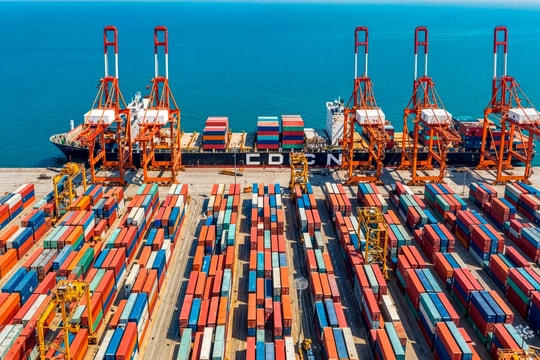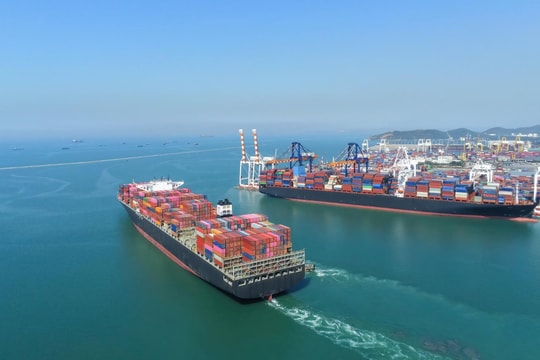
The Decision No.175QĐ-TTh dated January 27, 2001 approving the overall strategy on the development of Vietnams service sector through 2020 by the Prime Minister states: “Considering logistics as a key factor boosting manufacturing, distribution systems of other services and cargo flows.” Logistics services in Vietnam account for 15-20% GDP (about USD 12 billions). And matters of human resource development should be put in solemn and urgent consideration due to the increase of logistics services in the country (20%-25%/year).
A SHORTAGE OF QUANLITY AND AN INADEQUACY IN QUALITY
The use of outsourcing as a global trend of large business corporations will strongly affect the increase in needs for services and for developing services. In addition, taking advantages from being located on the maritime axis, Vietnam is expected to be a cargo transshipment center for populated markets.
Due to the rapid development, there has been a severe shortage of human resource for Vietnam logistics market. Most conferences heard that there has been a shortage in quality and an inadequacy in quality of skilled labors. Although there has been a development in 3PL services, there is still a distance in credits and in customer services between local businesses and foreign businesses. Beside the matter of low technology, a reason that can be accounted for is the lack of professionalism of human resource in the sector.
According to the Research and Logistics Development Institute in Vietnam, in the coming three years, there will be a need for 18,000 labors in the logistic service sector; manufacturers, trading and service businesses will be in need of a million staff members with logistics knowledge. According to the Vietnam Freight Forwarders Association (VIFFAS)’s estimation, in 140 business members there are about 4,000 employees – a professional workforce – together with a semi-professional one of 4,000-5,000 employees. Also according to VIFFAS, providing sources for logistics sector only meet 40% requirements. In reality, there is a shortage of qualified skilled staff in most of logistics service businesses in Vietnam.
The workforce at the present comes from different sources. Management personnel are normally key cadres to be deployed in logistics companies. They are being trained to meet the needs of management work. However, most of them are lack of business experience and knowledge, not being updated with new information and not having persuasive leadership style and management skills. Professional workforce are graduated ones, but from different majors; and there has even been the fact that young ones are not allowed to participate in planning policies. The unskilled workforce as porters, drivers, loading/unloading agents, checkers… has low education background and lack working professionalism. Mr. Tran Anh Tuan, Vice Director, Center of Forecasting Manpower Needs and Labor Market Information HCMC, revealed that only 1-2% of the workforce received good training.
Another survey by the Logistic Institute showed that 53.3% businesses are in need of staff members with logistics knowledge and skills; 30% businesses need training programs for their staff; and only 6.7% businesses satisfy with their staff’s qualification.
CURRENT STATE OF LOGISTIC TRAINING

According to VIFFAS, logistics training programs in Vietnam are too sketchy and too general. In the school year of 2008, the University of Transport (HCMC) started its first course on Logistics Administration and Multimodal Transport. This is the first and only university in Vietnam having courses of the kind. Other universities and colleges of trade, maritime and transport have just have courses on sea transport and foreign trade insurance, which belong to sea transport and foreign trade forwarding. And some other universities which have logistics and supply chain management in their syllabus, normally belonging to faculties of business administration, economy transport, foreign trade, commerce and tourism, give very basic knowledge on trade and transport. Worse, there are a few course books and documents. And even worse, there are a few experts than required.
Besides, there are associations or group of businesses hold short-term courses by co-operating with foreign partners or free-lance lecturers. The Logistics Institute, belonging to VIFFAS, in co-operation with International Federation of Freight Forwarders Associations (FIATA) has had world-recognized FIATA Diploma program on “International Forwarding and Transport Management.” The Institute has also joined Education Department of Asian Federation of Forwarders Association to build logistics training programs to ASEAN members. There have also been co-operations between it and other partners giving courses on forwarding, and sea cargo consolidation; or between it and the College of Customs giving courses on Customs Clearance agencies.
In the Center of Vietnam, the University of Danang in co-operation with the University of Liège has had two courses on “Professional Master in Transport and Logistics.” But the students have been a few in number and there are differences between Vietnam and Europe on customs inspection, connecting infrastructure network, and security management levels in ISPS Code.
IATA, together with Vietnam Airlines, has hold several training courses on air forwarding with world-recognized IATA certificates. Besides, Project of Developing Human Resources of International Logistics Aviation Services which has first been carried out in Vietnam by Logistic Knowledge Company and Work Global was enrolling students. However, it has not been working so well due to its impractical nature, limited quantity and localization.
A NEED FOR A COMPREHENSIVE LONG-TERM STRATEGY

Therefore, the developing of Vietnam logistics human resources should be considered as a continuous long-term strategy to the tendency of professionalism and standardization. For a long-term strategy, the Government and functional agencies should give support and sponsorships to build a particular policy and implement The Commerce Code, Logistics Chapter. Besides, there should be a system of national level to certify abilities to members operating in the logistics sector.
There should be encouraging policies from the Ministry of Education to open logistics faculties and departments in universities and colleges of economy and trade, supporting them in building standardized programs, syllabus and a system of alliance study.
Provinces with potential for sea port services and logistics as Ba Ria-Vung Tau should have training programs to management personnel, who will be in charge of modern logistics centers. Besides, there should be supporting measures from the local authorities to training programs on logistics and supply chain for businesses in the area, and there should be long-term strategies to develop human resources in the logistics sector.
Another matter of concerns is seeking national and international sponsorships for short-term courses locally and abroad. There should be co-operations with FIATA, IATA and non-governmental associations for a regular training financial source. And there should be close connections between businesses and associations for holding human resource training courses.







.png)
.png)






